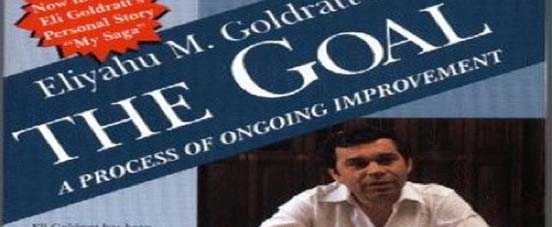- Articles ›
- Operations and IT ›
- The Goal - Book Review ! Articles
The Goal - Book Review !
“The Goal” is a book which explains on how to go about attaining goals in real life and business. The Goal written by , Eliyahu Moshe Goldratt, provides a convincing tale that challenges the way we look at how we evaluate operational improvement. Goldratt's analysis divides the operations of any organization into three entities
- Inventory
- Overhead
- Throughput

Goldratt explains quite a few management skills to be inherited in any professional’s life with ease in this inspiring novel based management textbook. The ideas expressed are simply conceptualized in the form of a novel, which any professional can easily relate to. Alex is the protagonist of the The Goal.
The book mainly revolves around the character, Alex, his superiors and his team along with his management Guru, Jonah, who changes the whole perspective of Alex’s life with his simple messages, opens Alex to brand new world of bottlenecks, variability, etc. and their effects in the working of any manufacturing firm. The Goal is a highly relevant book as per the current scenarios of business. An Engineer with an MBA degree, Mr. Alex Rogo is struggling to get a loss making company to a profit making one. The story also captures his family in the back-ground to enlighten the drudgeries of a manufacturing engineer’s life.
At first look, the ideas Goldratt presents in The Goal emerges to apply to the world of manufacturing companies only. However, after full consideration the principles can be applied in the same way across all major types of organizations. Whether it’s a manufacturing automobile company like Honda or it is a service provider like Airtel, all can benefit from the theories put forward in The Goal.
While the primary work that supports the Theory of Constrains is greatly dependent upon formal queue theory, The Goal provides a solid, non-technical starting point for leaders to begin a discussion about productivity and the nature of improvement in their organizations.
The 3 important factors which the Goal explains are as below:
Inventory
Inventory is represented by the monies tied up in things the system intends to sell, i.e. any item within the system that is being or will be sold. This includes raw material from suppliers, work in progress and standing stock levels. Inventory reductions are positive movement, increases are negative movement.
Overhead:
Overhead is represented by the costs of doing business, other than inventory. Total costs less inventory costs, are overhead. As with inventory, overhead reductions are positive movement increases are negative movement.
Throughput
Throughput is represented by the monies coming into the organization in exchange for items produced. Throughput increases are positive movement, decreases are negative movement.
Goldratt, the creator of the “Theory of constraints”, in his work “The Goal”, explains a lot about managerial skills, to achieve higher productivity and efficiency, in a simple and lucid manner.
Let’s have a small look at the TOC.
Theory of Constraints
The Theory of Constraints defines a set of tools that change agents can use to manage constraints, thereby increasing profits. Most businesses can be viewed as a linked set of processes that transform inputs into saleable outputs. The Theory of Constraints is an organizational change method that is focused on profit improvement. The essential concept of TOC is that every organization must have at least one constraint.
TOC conceptually models this system as a chain, and advocates the familiar adage that a "chain is only as strong as its weakest link." Goldratt defines a five-step process that a change agent can use to strengthen the weakest link, or links. A constraint is any factor that limits the organization from getting more of whatever it strives for, which is usually profit. The Goal focuses on constraints as bottleneck processes in a job-shop manufacturing organization. However, many non-manufacturing constraints exist, such as market demand, or a sales department's ability to translate market demand into orders. In The Goal, Goldratt proves that most organizations have very few true constraints. Since the focus only needs to be on the constraints, implementing TOC can result in substantial improvement without tying up a great deal of resources, with results after three months of effort.
The article has been authored by the editorial team. The content on MBA Skool has been created for educational & academic purpose only.
If you are interested in writing articles for us, Submit Here
Share this Page on:
What is MBA Skool?About Us
MBA Skool is a Knowledge Resource for Management Students, Aspirants & Professionals.
Business Courses
Quizzes & Skills
Quizzes test your expertise in business and Skill tests evaluate your management traits
All Business Sections
Write for Us